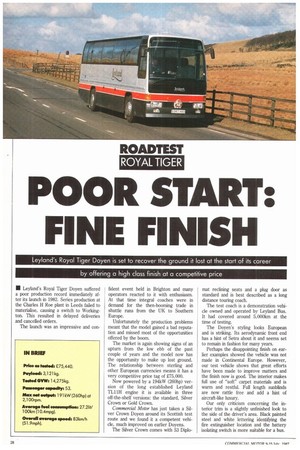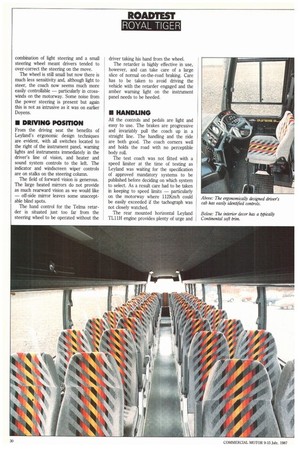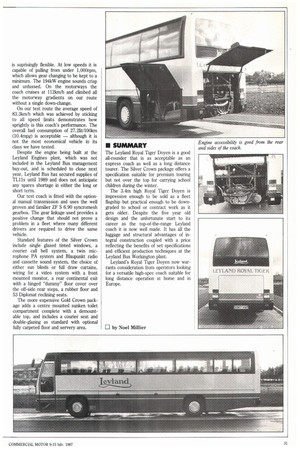POOR START:
Page 30

Page 32

Page 33

If you've noticed an error in this article please click here to report it so we can fix it.
FINE FINIS Leyland's Royal Tiger Doyen is set to recover the ground it lost at the start of its career by offering a high class finish at a competitive price
• Leyland's Royal Tiger Doyen suffered a poor production record immediately after its launch in 1982. Series production at the Charles H Roe plant in Leeds failed to materialise, causing a switch to Workington. This resulted in delayed deliveries and cancelled orders.
The launch was an impressive and con fident event held in Brighton and many operators reacted to it with enthusiasm. At that time integral coaches were in demand for the then-booming trade in shuttle runs from the UK to Southern Europe.
Unfortunately the production problems meant that the model gained a bad reputation and missed most of the opportunities offered by the boom.
The market is again showing signs of an upturn from the low ebb of the past couple of years and the model now has the opportunity to make up lost ground. The relationship between sterling and other European currencies means it has a very competitive price tag of £75,000.
Now powered by a 194kW (260hp) version of the long established Leyland TL11H engine it is available in three off-the-shelf versions: the standard, Silver Crown or Gold Crown.
Commercial Motor has just taken a Silver Crown Doyen around its Scottish test route and we found it a competent vehicle, much improved on earlier Doyens.
The Silver Crown comes with 53 Diplo mat reclining seats and a plug door as standard and is best described as a long distance touring coach.
The test coach is a demonstration vehicle owned and operated by Leyland Bus. It had covered around 5,0001cm at the time of testing.
The Doyen's styling looks European and is striking. Its aerodynamic front end has a hint of Setra about it and seems set to remain in fashion for many years.
Perhaps the disappointing finish on earlier examples showed the vehicle was not made in Continental Europe. However, our test vehicle shows that great efforts have been made to improve matters and the finish now is good. The interior makes full use of "soft" carpet materials and is warm and restful. Full length sunblinds are now rattle free and add a hint of aircraft-like luxury.
Our only criticism concerning the interior trim is a slightly unfinished look to the side of the driver's area. Black painted steel and white lettering identifying the fire extinguisher location and the battery isolating switch is more suitable for a bus. combination of light steering and a small steering wheel meant drivers tended to over-correct the steering on the move.
The wheel is still small but now there is much less sensitivity and, although light to steer, the coach now seems much more easily controllable — particularly in crosswinds on the motorway. Some noise from the power steering is present but again this is not as intrusive as it was on earlier Doyens.
• DRIVING POSMON
From the driving seat the benefits of Leyland's ergonomic design techniques are evident, with all switches located to the right of the instrument panel, warning lights and instruments immediately in the driver's line of vision, and heater and sound system controls to the left. The indicator and windscreen wiper controls are on stalks on the steering column.
The field of forward vision is generous. The large heated mirrors do not provide as much rearward vision as we would like — off-side mirror leaves some unacceptable blind spots.
The hand control for the Telma retarder is situated just too far from the steering wheel to be operated without the driver taking his hand from the wheel.
The retarder is highly effective in use, however, and can take care of a large slice of normal on-the-road braking. Care has to be taken to avoid driving the vehicle with the retarder engaged and the amber warning light on the instrument panel needs to be heeded.
• HANDLING
All the controls and pedals are light and easy to use. The brakes are progressive and invariably pull the coach up in a straight line. The handling and the ride are both good. The coach corners well and holds the road with no perceptible body roll.
The test coach was not fitted with a speed limiter at the time of testing as Leyland was waiting for the specification of approved mandatory systems to be published before deciding on which system to select. As a result care had to be taken in keeping to speed limits — particularly on the motorway where 1121(m/h could be easily exceeded if the tachograph was not closely watched.
The rear mounted horizontal Leyland TL11H engine provides plenty of urge and is suprisingly flexible. At low speeds it is capable of pulling from under 1,000rpm, which allows gear changing to be kept to a minimum. The 194kW engine sounds crisp and unfussed. On the motorways the coach cruises at 112krn/h and climbed all the motorway gradients on our route without a single down-change.
On our test route the average speed of 83.3km/h which was achieved by sticking to all speed limits demonstrates how sprightly is this coach's performance. The overall fuel consumption of 27.21it/100km (10.4mpg) is acceptable -although it is not the most economical vehicle in its class we have tested.
Despite the engine being built at the Leyland Engines plant, which was not included in the Leyland Bus management buy-out, and is scheduled to close next year, Leyland Bus has secured supplies of Mils until 1989 and does not anticipate any spares shortage in either the long or short term.
Our test coach is fitted with the optional manual transmission and uses the well proven and farnilier 2F S 6.90 syncromesh gearbox. The gear linkage used provides a positive change that should not prove a problem in a fleet where many different drivers are required to drive the same vehicle.
Standard features of the Silver Crown include single glazed tinted windows, a courier call bell system, a twin microphone PA system and Blaupunkt radio and cassette sound system, the choice of either sun blinds or full draw curtains, wiring for a video system with a front mounted monitor, a rear continental exit with a hinged "dummy" floor cover over the off-side rear steps, a rubber floor and 53 Diplomat reclining seats.
The more expensive Gold Crown package adds a centre mounted sunken toilet compartment complete with a demountable top, and includes a courier seat and double-glazing as standard with optional fully carpeted floor and servery area.
• SUMMARY
The Leyland Royal Tiger Doyen is a good all-rounder that is as acceptable as an express coach as well as a long distance tourer. The Silver Crown package offers a specification suitable for premium touring but not over the top for carrying school children during the winter.
The 3.4m high Royal Tiger Doyen is impressive enough to be sold as a fleet flagship but practical enough to be downgraded to school or contract work as it gets older. Despite the five year old design and the unfortunate start to its career as the top-of-the-range Leyland coach it is now well made. It has all the luggage and structural advantages of integral construction coupled with a price reflecting the benefits of set specifications and efficient production techniques at the Leyland Bus Workington plant.
Leyland's Royal Tiger Doyen now warrants consideration from operators looking for a versatile high-spec coach suitable for long distance operation at home and in Europe.




































































































